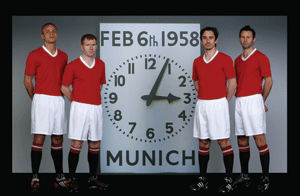Good day and welcome back to this WordPress.com weekly special tracking the origins of football. After a week off to allow people to catch up at the half way stage, we are back and this week we are going to take a look at how football was affected by war in Britain.
The most famous story from the war most likely comes from Christmas Eve, 1915, when both British and German forces laid down arms and joined to play a friendly game of football. The football was produced from materials around the battlefield and it is suggested that thousands of men took part in the friendly with the German regiment eventually coming out victorious at 3-2.
The inter-war years were dominated by Huddersfield Town, Everton and Arsenal, who won eleven of the eighteen league titles contested between them, with Huddersfield and Arsenal each grabbing a hat-trick, and Arsenal taking five in total, as well as two FA Cups.
By the turn of the 1930s the national side often played against other national teams from outside the British Isles. However, the FA’s resignation from FIFA in 1928 meant that England did not contest any of the first three World Cups. The 1939–40 season was abandoned in September 1939 following the outbreak of World War II. However, as with World War I, a special wartime league was played throughout the war years, with the FA Cup again suspended. Ten regional “mini-leagues” were initially established in 1939 as well as the Football League War Cup which ran six seasons from 1939 to 1945 with West Ham United, Preston North End, Wolverhampton Wanderers, Blackpool and Bolton Wanderers winning the trophy while in 1943-44 Aston Villa and Charlton Athletic shared the trophy after drawing 1-1. Various leagues and cups were organised throughout the war years for five seasons until the FA Cup resumed in 1945–46. The Football League returned the following season.
The post-war years were dominated first by Manchester United with three titles and an FA Cup and Wolverhampton Wanderers with three titles and two FA Cups. Although Manchester United’s progress was halted by the 1958 Munich air disaster. The Munich air disaster took place on 6 February 1958, when British European Airways Flight 609 crashed on its third attempt to take off from a slush-covered runway at Munich-Riem Airport in Munich, West Germany. On board the plane was the Manchester United football team, nicknamed the “Busby Babes”, along with a number of supporters and journalists. Twenty of the 44 people on board the aircraft died in the crash. The injured, some of whom had been knocked unconscious, were taken to the Rechts der Isar Hospital in Munich where three more died, resulting in a total of 23 fatalities with 21 survivors.
The disaster which left the Manchester United side both depleted and devastated is still remembered to this day at Old Trafford with a commemorative clock and annual tributes to the men who lost their lives in the horrific disaster.
However, during this time English football was being outstripped abroad. England lost 1-0 to the United States at the 1950 World Cup, and then lost 6-3 to Hungary at Wembley in 1953. English clubs had little success in the European club competitions that had been set up. The FA and the Football League persuaded the 1954–55 league champions Chelsea against participating in the first European Cup competition which took place in 1955-56. Chelsea’s successors as champions, Manchester United ignored such advice and went on to reach the semi-final of the 1956–57 European Cup, where they lost to the eventual winners Real Madrid.
In the following seasons European Cup, United defeated Red Star Belgrade in the quarter final only to be decimated in the air disaster at Munich when eight players died returning from the second leg match in Belgrade. Their patched-up team managed to beat A.C. Milan in the home leg at Old Trafford in the semi-finals, but went out of the competition when they lost the return leg 4-0. In the 1958–59 European Cup Wolverhampton Wanderers went out in the first round.
However, the following season they managed to reach the quarter final, where they lost to eventual winners Real Madrid. Two English teams reached the finals of the first two Inter-Cities Fairs Cup tournaments. In the 1955–58 Fairs Cup, which took place over three seasons, and which allowed only one team from each participating city, a London XI made up of players from various London clubs, reached the final where they lost 8-2 to over two legs to Barcelona. The next Fairs Cup also took place over three seasons from 1958 to 1960, and Birmingham City reached the final where they also lost to Barcelona, 4-1 in a one-off final.
The Football League was re-organised for the 1958–59 season with Third Divisions North and South discontinued. The top half of each regional Third Division from the previous season formed a new Third Division, while the lower halves formed the new Fourth Division. The restructuring of the league format to the four divisions is what can be seen today. The Npower Championship, League One and League Two make up the three divisions and the Barclays Premier League is the top flight of football now, having broken away from the Football League in 1992.
Thank you very much for reading this latest installment of the origins of football.
I hope you have enjoyed it and feel free to leave any comments on this post.
I look forward to seeing you next week when we look at the rise of international football.
Have a great weekend.
BH



